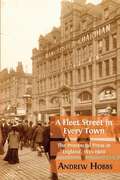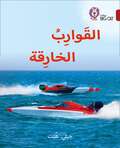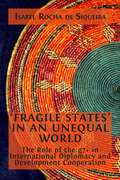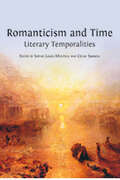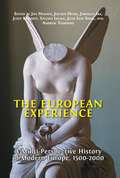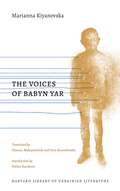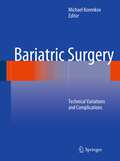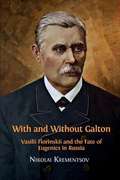- Table View
- List View
Stories from Quechan Oral Literature
by A. M. Halpern Amy MillerThe Quechan are a Yuman people who have traditionally lived along the lower part of the Colorado River in California and Arizona. They are well known as warriors, artists, and traders, and they also have a rich oral tradition. The stories in this volume were told by tribal elders in the 1970s and early 1980s. The eleven narratives in this volume take place at the beginning of time and introduce the reader to a variety of traditional characters, including the infamous Coyote and also Kwayúu the giant, Old Lady Sanyuuxáv and her twin sons, and the Man Who Bothered Ants. This book makes a long-awaited contribution to the oral literature and mythology of the American Southwest, and its format and organization are of special interest. Narratives are presented in the original language and in the storytellers’ own words. A prosodically-motivated broken-line format captures the rhetorical structure and local organization of the oral delivery and calls attention to stylistic devices such as repetition and syntactic parallelism. Facing-page English translation provides a key to the original Quechan for the benefit of language learners. The stories are organized into "story complexes”, that is, clusters of narratives with overlapping topics, characters, and events, told from diverse perspectives. In presenting not just stories but story complexes, this volume captures the art of storytelling and illuminates the complexity and interconnectedness of an important body of oral literature. Stories from Quechan Oral Literature provides invaluable reading for anyone interested in Native American cultural heritage and oral traditions more generally.
Yeats's Mask - Yeats Annual No. 19
by Margaret Harper Warwick GouldYeats’s Mask, Yeats Annual No. 19 is a special issue in this renowned research-level series. Fashionable in the age of Wilde, the Mask changes shape until it emerges as Mask in the system of A Vision. Chronologically tracing the concept through Yeats’s plays and those poems written as ‘texts for exposition’ of his occult thought which flowers in A Vision itself (1925 and 1937), the volume also spotlights ‘The Mask before The Mask’ numerous plays including Cathleen Ni-Houlihan, The King’s Threshold, Calvary, The Words upon the Window-pane, A Full Moon in March and The Death of Cuchulain. There are excurses into studies of Yeats’s friendship with the Oxford don and cleric, William Force Stead, his radio broadcasts, the Chinese contexts for his writing of ‘Lapis Lazuli’. His self-renewal after The Oxford Book of Modern Verse, and the key occult epistolary exchange ‘Leo Africanus’, edited from MSS by Steve L. Adams and George Mills Harper, is republished from the elusive Yeats Annual No. 1 (1982). The essays are by David Bradshaw, Michael Cade-Stewart, Aisling Carlin, Warwick Gould, Margaret Mills Harper, Pierre Longuenesse, Jerusha McCormack, Neil Mann, Emilie Morin, Elizabeth Müller and Alexandra Poulain, with shorter notes by Philip Bishop and Colin Smythe considering Yeats’s quatrain upon remaking himself and the pirate editions of The Land of Heart’s Desire. Ten reviews focus on various volumes of the Cornell Yeats MSS Series, his correspondence with George Yeats, and numerous critical studies. Yeats Annual is published by Open Book Publishers in association with the Institute of English Studies, University of London.
Studies in Rabbinic Hebrew
by Shai HeijmansThis volume presents a collection of articles centring on the language of the Mishnah and the Talmud – the most important Jewish texts (after the Bible), which were compiled in Palestine and Babylonia in the latter centuries of Late Antiquity. Despite the fact that Rabbinic Hebrew has been the subject of growing academic interest across the past century, very little scholarship has been written on it in English. Studies in Rabbinic Hebrew addresses this lacuna, with eight lucid but technically rigorous articles written in English by a range of experienced scholars, focusing on various aspects of Rabbinic Hebrew: its phonology, morphology, syntax, pragmatics and lexicon. This volume is essential reading for students and scholars of Rabbinic studies alike, and constitutes the first in a new series, Studies in Semitic Languages and Cultures, in collaboration with the Faculty of Asian and Middle Eastern Studies at the University of Cambridge.
Studies in Rabbinic Hebrew
by Shai HeijmansThis volume presents a collection of articles centring on the language of the Mishnah and the Talmud – the most important Jewish texts (after the Bible), which were compiled in Palestine and Babylonia in the latter centuries of Late Antiquity. Despite the fact that Rabbinic Hebrew has been the subject of growing academic interest across the past century, very little scholarship has been written on it in English. Studies in Rabbinic Hebrew addresses this lacuna, with eight lucid but technically rigorous articles written in English by a range of experienced scholars, focusing on various aspects of Rabbinic Hebrew: its phonology, morphology, syntax, pragmatics and lexicon. This volume is essential reading for students and scholars of Rabbinic studies alike, and constitutes the first in a new series, Studies in Semitic Languages and Cultures, in collaboration with the Faculty of Asian and Middle Eastern Studies at the University of Cambridge.
Toevallige ontmoetingen: Bio-ethiek voor een gehavende planeet
by Kristien HensIn dit rigoureuze en noodzakelijke boek brengt Kristien Hens bio-ethiek en filosofie van de biologie bij elkaar, met het argument dat het ethisch noodzakelijk is om in het wetenschappelijk onderzoek een plaatsje vrij te houden voor de filosofen. Hun rol is behalve ethisch ook conceptueel: zij kunnen de kwaliteit en de coherentie van het wetenschappelijk onderzoek verbeteren door erop toe te zien dat specifieke concepten op een consistente en doordachte manier worden gebruik binnen interdisciplinaire projecten. Hens argumenteert dat toeval en onzekerheid een centrale rol spelen in de bio-ethiek, maar dat die in een spanningsrelatie kunnen raken met de pogingen om bepaalde theorieën ingang te doen vinden als wetenschappelijke kennis: bij het beschrijven van organismen en praktijken creëren we op een bepaalde manier de wereld. Hens stelt dat dit noodzakelijk een ethische activiteit betreft.
Toevallige ontmoetingen: Bio-ethiek voor een gehavende planeet
by Kristien HensIn dit rigoureuze en noodzakelijke boek brengt Kristien Hens bio-ethiek en filosofie van de biologie bij elkaar, met het argument dat het ethisch noodzakelijk is om in het wetenschappelijk onderzoek een plaatsje vrij te houden voor de filosofen. Hun rol is behalve ethisch ook conceptueel: zij kunnen de kwaliteit en de coherentie van het wetenschappelijk onderzoek verbeteren door erop toe te zien dat specifieke concepten op een consistente en doordachte manier worden gebruik binnen interdisciplinaire projecten. Hens argumenteert dat toeval en onzekerheid een centrale rol spelen in de bio-ethiek, maar dat die in een spanningsrelatie kunnen raken met de pogingen om bepaalde theorieën ingang te doen vinden als wetenschappelijke kennis: bij het beschrijven van organismen en praktijken creëren we op een bepaalde manier de wereld. Hens stelt dat dit noodzakelijk een ethische activiteit betreft.
A Fleet Street In Every Town: The Provincial Press In England, 1855-1900
by Andrew HobbsAt the heart of Victorian culture was the local weekly newspaper. More popular than books, more widely read than the London papers, the local press was a national phenomenon. This book redraws the Victorian cultural map, shifting our focus away from one centre, London, and towards the many centres of the provinces. It offers a new paradigm in which place, and a sense of place, are vital to the histories of the newspaper, reading and publishing. Hobbs offers new perspectives on the nineteenth century from an enormous yet neglected body of literature: the hundreds of local newspapers published and read across England. He reveals the people, processes and networks behind the publishing, maintaining a unique focus on readers and what they did with the local paper as individuals, families and communities. Case studies and an unusual mix of quantitative and qualitative evidence show that the vast majority of readers preferred the local paper, because it was about them and the places they loved. A Fleet Street in Every Town positions the local paper at the centre of debates on Victorian newspapers, periodicals, reading and publishing. It reorientates our view of the Victorian press away from metropolitan high culture and parliamentary politics, and towards the places where most people lived, loved and read. This is an essential book for anybody interested in nineteenth-century print culture, journalism and reading.
A Fleet Street In Every Town: The Provincial Press in England, 1855-1900
by Andrew HobbsAt the heart of Victorian culture was the local weekly newspaper. More popular than books, more widely read than the London papers, the local press was a national phenomenon. This book redraws the Victorian cultural map, shifting our focus away from one centre, London, and towards the many centres of the provinces. It offers a new paradigm in which place, and a sense of place, are vital to the histories of the newspaper, reading and publishing. Hobbs offers new perspectives on the nineteenth century from an enormous yet neglected body of literature: the hundreds of local newspapers published and read across England. He reveals the people, processes and networks behind the publishing, maintaining a unique focus on readers and what they did with the local paper as individuals, families and communities. Case studies and an unusual mix of quantitative and qualitative evidence show that the vast majority of readers preferred the local paper, because it was about them and the places they loved. A Fleet Street in Every Town positions the local paper at the centre of debates on Victorian newspapers, periodicals, reading and publishing. It reorientates our view of the Victorian press away from metropolitan high culture and parliamentary politics, and towards the places where most people lived, loved and read. This is an essential book for anybody interested in nineteenth-century print culture, journalism and reading.
‘Fragile States’ in an Unequal World
by Isabel Rocha de SiqueiraThis is a book about people. ‘Fragile States’ in an Unequal World: The Role of the g7+ in International Diplomacy and Development Cooperation introduces the members of the g7+, a group formed by 20 conflict-affected states: why they came to believe in politics and policy; how they feel about their work, their family and their communities; and what they want to leave behind for the next generations It is the story of their personal and collective values, their mistakes, and the challenges they faced, and it will resonate with anyone who has tried to organize and work with a group of very different people.
‘Fragile States’ in an Unequal World
by Isabel Rocha de SiqueiraThis is a book about people. ‘Fragile States’ in an Unequal World: The Role of the g7+ in International Diplomacy and Development Cooperation introduces the members of the g7+, a group formed by 20 conflict-affected states: why they came to believe in politics and policy; how they feel about their work, their family and their communities; and what they want to leave behind for the next generations It is the story of their personal and collective values, their mistakes, and the challenges they faced, and it will resonate with anyone who has tried to organize and work with a group of very different people.
Destins de femmes: French Women Writers, 1750-1850
by John Claiborne IsbellDestins de femmes is the first comprehensive overview of French women writers during the turbulent period of 1750-1850. John Isbell provides an essential collection that illuminates the impact women writers had on French literature and politics during a time marked by three revolutions, the influx of Romantic art, and rapid technological change.
Destins de femmes: French Women Writers, 1750-1850
by John Claiborne IsbellDestins de femmes is the first comprehensive overview of French women writers during the turbulent period of 1750-1850. John Isbell provides an essential collection that illuminates the impact women writers had on French literature and politics during a time marked by three revolutions, the influx of Romantic art, and rapid technological change.
The European Experience
by Jan Hansen;Jochen Hung;Jaroslav Ira;Judit Klement;Sylvain Lesage;Juan Luis Simal;Andrew TompkinsThe European Experience brings together the expertise of nearly a hundred historians from eight European universities to internationalise and diversify the study of modern European history, exploring a grand sweep of time from 1500 to 2000.
The European Experience
by Jan Hansen;Jochen Hung;Jaroslav Ira;Judit Klement;Sylvain Lesage;Juan Luis Simal;Andrew TompkinsThe European Experience brings together the expertise of nearly a hundred historians from eight European universities to internationalise and diversify the study of modern European history, exploring a grand sweep of time from 1500 to 2000.
A Lexicon of Medieval Nordic Law
by Jeffrey Love, Inger Larsson, Ulrika Djärv, Christine Peel, and Erik SimensenA Lexicon of Medieval Nordic Law is an indispensable resource for scholars and students of medieval Scandinavia. This polyglot dictionary draws on the vast and vibrant range of vernacular legal terminology found in medieval Scandinavian texts – terminology which yields valuable insights into the quotidian realities of crime and retribution; the processes, application and execution of laws; and the cultural and societal concerns underlying the development and promulgation of such laws.
ANZUS and the Early Cold War: Strategy And Diplomacy Between Australia, New Zealand And The United States, 1945-1956
by Andrew KellyThe ANZUS Alliance was a defence arrangement between Australia, New Zealand and the United States that shaped international policy in the aftermath of the Second World War and the early stages of the Cold War. Forged by influential individuals and impacting on global events including the Japanese Peace Treaty, the Korean War and the Suez Crisis, the ANZUS Alliance was a crucial factor in the seismic changes that took place in the second half of the twentieth century. In this compact and accessible study Andrew Kelly lays out the tensions that underpinned the formation of the Alliance, as each power sought to extract maximum influence and prestige, and examines how the ANZUS powers worked together (or failed to do so) when responding to massive global events including the rise of the People’s Republic of China and the waning of the British Empire. Kelly comprehensively explores the reasons why Australia and New Zealand disagreed so regularly about mutual security issues, how US global leadership shaped ANZUS, and the British impact on the trilateral relationship, and outlines how these issues set the foundations for today’s world order. ANZUS and the Early Cold War is essential reading for historians of Australian, New Zealand and American international relations in the twentieth century. Its concise format and readable style will also appeal to general readers interested in the history and foreign policies of these nations, and to anyone who wants to know more about the individual and geopolitical tensions that beset any major alliance.
ANZUS and the Early Cold War: Strategy and Diplomacy Between Australia, New Zealand and the United States, 1945-1956
by Andrew KellyThe ANZUS Alliance was a defence arrangement between Australia, New Zealand and the United States that shaped international policy in the aftermath of the Second World War and the early stages of the Cold War. Forged by influential individuals and impacting on global events including the Japanese Peace Treaty, the Korean War and the Suez Crisis, the ANZUS Alliance was a crucial factor in the seismic changes that took place in the second half of the twentieth century. In this compact and accessible study Andrew Kelly lays out the tensions that underpinned the formation of the Alliance, as each power sought to extract maximum influence and prestige, and examines how the ANZUS powers worked together (or failed to do so) when responding to massive global events including the rise of the People’s Republic of China and the waning of the British Empire. Kelly comprehensively explores the reasons why Australia and New Zealand disagreed so regularly about mutual security issues, how US global leadership shaped ANZUS, and the British impact on the trilateral relationship, and outlines how these issues set the foundations for today’s world order. ANZUS and the Early Cold War is essential reading for historians of Australian, New Zealand and American international relations in the twentieth century. Its concise format and readable style will also appeal to general readers interested in the history and foreign policies of these nations, and to anyone who wants to know more about the individual and geopolitical tensions that beset any major alliance.
THE VOICES. OF BABYN YAR
by Marianna KiyanovskaWith The Voices of Babyn Yar—a collection of stirring poems by Marianna Kiyanovska— the award-winning Ukrainian poet honors the victims of the Holocaust as she writes their stories of horror, death, and survival by projecting their own imagined voices. Artful and carefully intoned, the poems convey the experiences of ordinary civilians going through unbearable events leading to the massacre at Kyiv’s Babyn Yar from a first-person perspective to an effect that is simultaneously immersive and estranging. While conceived as a tribute to the fallen, the book raises difficult questions about memory, responsibility, and commemoration of those who had witnessed an evil that verges on the unspeakable.
From Dust to Digital: Ten Years Of The Endangered Archives Programme
by Maja KominkoMuch of world’s documentary heritage rests in vulnerable, little-known and often inaccessible archives. Many of these archives preserve information that may cast new light on historical phenomena and lead to their reinterpretation. But such rich collections are often at risk of being lost before the history they capture is recorded. This volume celebrates the tenth anniversary of the Endangered Archives Programme at the British Library, established to document and publish online formerly inaccessible and neglected archives from across the globe. From Dust to Digital showcases the historical significance of the collections identified, catalogued and digitised through the Programme, bringing together articles on 19 of the 244 projects supported since its inception. These contributions demonstrate the range of materials documented — including rock inscriptions, manuscripts, archival records, newspapers, photographs and sound archives — and the wide geographical scope of the Programme. Many of the documents are published here for the first time, illustrating the potential these collections have to further our understanding of history.
Bariatric Surgery: Technical Variations and Complications
by Michael KorenkovThe increasing prevalence of obesity in many countries means that it should now be considered a pandemic. It is widely recognized that obesity increases the risk of a variety of life-threatening conditions, including heart disease, diabetes, and hypertension. Bariatric surgery is often the most effective way to treat such morbid obesity. Nevertheless, while various bariatric procedures have been proposed, to date standards have been lacking. In this book, leading experts from around the world discuss all aspects of bariatric surgery and present their own favored versions of surgical procedures with the aid of informative illustrations. Technical nuances are carefully described, and detailed attention is devoted to potential complications and how to avoid them. The expertise of the authors and the range of techniques considered guarantee that both trainees in bariatric surgery and experienced surgeons will find this book to be an invaluable source of information and guidance in their daily work.
With and Without Galton: Vasilii Florinskii And The Fate Of Eugenics In Russia
by Nikolai KrementsovIn 1865, British polymath Francis Galton published his initial thoughts about the scientific field that would become ‘eugenics.’ The same year, Russian physician Vasilii Florinskii addressed similar issues in a sizeable treatise, entitled Human Perfection and Degeneration. Initially unheralded, Florinskii’s book would go on to have a remarkable afterlife in twentieth- and twenty-first-century Russia. In this lucid and insightful work, Nikolai Krementsov argues that the concept of eugenics brings together ideas, values, practices, and fears energised by a focus on the future. It has proven so seductive to different groups over time because it provides a way to grapple with fundamental existential questions of human nature and destiny. With and Without Galton develops this argument by tracing the life-story of Florinskii’s monograph from its uncelebrated arrival amid the Russian empire’s Great Reforms, to its reissue after the Bolshevik Revolution, its decline under Stalinism, and its subsequent resurgence: first, as a founding document of medical genetics, and most recently, as a manifesto for nationalists and racial purists. Krementsov’s meticulously researched ‘biography of a book’ sheds light not only on the peculiar fate of eugenics in Russia, but also on its convoluted transnational history, elucidating the field’s protean nature and its continuing and contested appeal to diverse audiences, multiple local trajectories, and global trends. It is required reading for historians of eugenics, science, medicine, education, literature, and Russia, and it will also appeal to the general reader looking for a deeper understanding of this challenging subject. Victoria College, University of Toronto, has generously contributed to the publication of this volume.
With and Without Galton: Vasilii Florinskii and the Fate of Eugenics in Russia
by Nikolai KrementsovIn 1865, British polymath Francis Galton published his initial thoughts about the scientific field that would become ‘eugenics.’ The same year, Russian physician Vasilii Florinskii addressed similar issues in a sizeable treatise, entitled Human Perfection and Degeneration. Initially unheralded, Florinskii’s book would go on to have a remarkable afterlife in twentieth- and twenty-first-century Russia. <p><p> In this lucid and insightful work, Nikolai Krementsov argues that the concept of eugenics brings together ideas, values, practices, and fears energised by a focus on the future. It has proven so seductive to different groups over time because it provides a way to grapple with fundamental existential questions of human nature and destiny. With and Without Galton develops this argument by tracing the life-story of Florinskii’s monograph from its uncelebrated arrival amid the Russian empire’s Great Reforms, to its reissue after the Bolshevik Revolution, its decline under Stalinism, and its subsequent resurgence: first, as a founding document of medical genetics, and most recently, as a manifesto for nationalists and racial purists. <p> Krementsov’s meticulously researched ‘biography of a book’ sheds light not only on the peculiar fate of eugenics in Russia, but also on its convoluted transnational history, elucidating the field’s protean nature and its continuing and contested appeal to diverse audiences, multiple local trajectories, and global trends. It is required reading for historians of eugenics, science, medicine, education, literature, and Russia, and it will also appeal to the general reader looking for a deeper understanding of this challenging subject.
Dickens’s Working Notes for Dombey and Son
by Tony LaingThis critical edition of the working notes for Dombey and Son (1848) is ideal for readers who wish to know more about Charles Dickens’s craft and creativity. Drawing on the author’s manuscript in the Victoria and Albert Museum, London—and containing hyperlinked facsimiles—Dickens’s Working Notes for Dombey and Son offers a new digital transcription with a fresh commentary by Tony Laing. Unique and innovative, this is the only edition to make Dickens’s working methods visible. John Mullan has called Dombey and Son Dickens’s 'first great novel.' Set amid the coming of the railways, it tells the story of a powerful man—typical of the commercial and banking magnates of the period—and the effect he has on his family and those around him. Laing presents the worksheets and other materials (transcribed for the first time) that together grew into the novel. Reading the book alongside this edition of the notes enlarges the understanding of Dickens’s art among teachers, students, researchers and Dickens enthusiasts. As cultural tastes shift from print to digital, Dickens’s Working Notes helps preserve Dickens’s work for the future. The magnifying and linking functions of the edition mean that the notes are more easily and usefully—not to mention accessibly—exhibited here than elsewhere. Laing gives present-day readers the chance not only to recapture the effect of serial publication but also to gain greater insight into the making of a work which, by general agreement and Dickens’s own admission, has a special place in his development as a novelist.
Essays on Paula Rego: Smile When You Think About Hell
by Maria Manuel LisboaIn these powerful and stylishly written essays, Maria Manuel Lisboa dissects the work of Paula Rego, the Portuguese-born artist considered one of the greatest artists of modern times. Focusing primarily on Rego’s work since the 1980s, Lisboa explores the complex relationships between violence and nurturing, power and impotence, politics and the family that run through Rego’s art. Taking a historicist approach to the evolution of the artist’s work, Lisboa embeds the works within Rego’s personal history as well as Portugal’s (and indeed other nations’) stories, and reveals the interrelationship between political significance and the raw emotion that lies at the heart of Rego’s uncompromising iconographic style. Fundamental to Lisboa’s analysis is an understanding that apparent opposites – male and female, sacred and profane, aggression and submissiveness – often co-exist in Rego’s work in a way that is both disturbing and destabilising.

